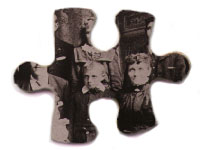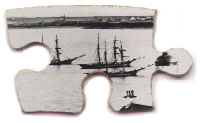



Caithness Archives
Accounts of the County:The Victorian Angler in Caithness
The socially ambitious industrialists of the 19th century sought to emulate the leisure habits of the aristocracy, and the aristocracy, in general, followed the lead of Royalty. Balmoral enchanted Queen Victoria; the spell spread down through the social scale, and the Highlands found itself invaded by a human animal far different to the breed of romantic traveller Walter Scott's fictions had brought to the North. Here were people uninterested in picturesque scenery, ancient poetry, sedentary dreamings amidst ruined castles: these new arrivals were action people; for them, deeds and doing were everything. And what better in the game-rich Highlands than the active sporting pursuits; shooting and fishing?
Thomas Tod Stoddart was a Lowlander, from Kelso. He cut his angling teeth on the Tweed, then, as now, an exclusive and prolific salmon river. Stoddart could write as well as he could fish, and his Angler's Companion to the Rivers and Lochs of Scotland is one of the best of many fine 19th century angling books. In 1851, Stoddart came North to dip his line in the lochs and rivers of Caithness and Sutherland. Here is what he had to say about the fishings in Caithness:
The Langwell and Berriedale rivers, in the county of Caithness, contain salmon of fine quality. These rivers unite when about two hundred yards from the sea; and, as is the case generally throughout Scotland, the breed of fish native to one is rarely to be found in the other. The proprietor of the fishings is Donald Horne, Esq. of Langwell. A flood during the grilse season insures good sport on the Berriedale. Not far off is the Dunbeath river, belonging to William Sinclair, Esq. of Freswick. It is also visited, although sparingly, by salmon and sea-trout. The Wick is a dull sluggish stream, partaking of the character of the district through which it flows. A few sea-trout, and occasionally a grilse or two, visit its pools; but, as an angling river, it is not held in very great repute. In Watten Loch, a considerable sheet of water situated between Wick and Thurso, there is excellent trouting during the summer and autumn months. I fished in September 1851, in company with Mr Henderson, procurator-fiscal for the county, who has a boat on the loch, and on that occasion we captured a number of nice trout, averaging half a pound in weight. Among these was one peculiarly marked, and resembling in every respect a small sea-trout. This variety, of which specimens are frequently caught in Loch Watten, reminded me much of a similarly marked variety that, in my younger days, existed in Compensation Pond, near Edinburgh. Its origin was traced to the circumstance of sea-trout from the Esk below having had access, before the damming up of the valley, to the upper parts of Glencorse burn. In like manner, to Loch Watten and its feeders, sea-trout at one time are known to have had access through the channel of the river Wick, which access has for many years been intercepted by the interposition of a wall or dyke, of considerable height. The silvery variety I allude to, in all probability, therefore, owes its origin to those fish, the spawn of which, by the construction of the above-mentioned barrier, were prevented from performing their migrations seaward, and have become reconciled to their fresh-water abode.
The Water of Wester, passing through a loch of the same name, flows into Sinclair Bay, at a distance of four or five miles north from Wick. It affords occasionally tolerable sea-trout fishing, but is wont to be disturbed by the nets and devices of poachers.
Sarclet loch is situated in a southerly direction from Wick, and contains yellow trout of large dimensions. Near it is the loch of Yarrows, also in good repute. In 1849, a trout of 5lb. in weight was taken out of it with the fly. The angling in loch Scarmlet corresponds to some extent with that on Loch Watten, with which sheet of water it is connected.
The Thurso river takes its rise in the heights of the parish of Halkirk, where it is connected with at least twenty lakes of various sizes. Of these lochs More and Calder are the principal ones. These all contain trout in abundance, and in Loch Calder charr are found. The length of the Thurso is about thirty miles; its greatest breadth nearly one hundred yards. Like those of the Wick river, its banks are totally destitute of wood. The salmon-fishings, which belong to Sir George Sinclair, Bart, are held on a long lease by Mr. William Dunbar. Cruive and bag-net fishings were formally carried out at the mouth; but these systems are now disused, and angling with the rod substituted in their place. Mr Dunbar the tenant, is known to the public as the companion of Mr St John in his tour through Sutherland, and, it is understood, greatly assisted that gentleman during his researches in that interesting country. He is an excellent enthusiastic angler and general sportsman, as well as a collector and assorter of subjects of natural history. His museum, which I saw when at Lochinver, and which has now been transferred, I presume, to the banks of the Thurso, included splendid specimens of the predatory and aquatic birds native to the mountains and coasts of the north of Scotland.
The Thurso river, from its extent, admits of a number of rods, from eight to ten being used upon it at one and the same time; and tha casts so proportioned out by Mr Dunbar to prevent the interference, when angling, of one party with another. Attendants are provided to point out the salmon pools, and give all necessary assistance to the angler. The charge per month is |12, 10s. for each rod, including attendance and the use of a car, by means of which each party is conveyed to his respective fishing-ground, and taken back in the evening.
Mr Dunbar has fitted out Brawl Castle for the especial accommodation of sportsmen; and those frequenting it, whether for the purposes of angling or grouse-shooting, will find their quarters comfortable and convenient. The Thurso, now converted into an angling river, gives promise of taking a lead, in that character, among our Scottish streams. It is undoubtedly one of the earliest waters, with respect to clean salmon, in Britain, and its capabilities in the shape of fine spawning-ground, and good shelter for fish, are very extensive. Last year, (1852), upwards of seven hundred clean salmon and grilses were taken out of it by the rod; and had the grilse season proved a favourable one, which owing to the continued drought it was far from being, probably three times that number of fish would have been captured. The most successful fisher of the season was Major Gordon Cumming, who is well known in the north as an experienced salmon-slayer; his renown, indeed, in this respect, stands on a level with the more terrible reputation aquired by his brother the lion-hunter.
Major Gordon Cumming was so kind as to enclose for me recently a few of the ascertained killers during the spring months. They were designed by him, after a good deal of experimenting, expressly for the Thurso river. With one exception, (that of a white-top), they have all mixed wings, in which bustard fibres, the golden pheasant tail, speckled turkey and macaw feelers, prevail. The bodies are respectively formed of various flosses; green olive, purple, and that tinge or colour which pervades the mussel silk, or Pinna marina. The lace is fretted - in the large sizes of hook, both fretted and flat, gold and silver alternately. The shouldering - blue jay, and black hackle to correspond with olive-brown body; grouse feather over green parrot to correspond with olive-green body; twitch of dyed pigs' wool, orange and red, with dyed purple hackle to correspond with purple body. One of the largest sizes of hooks having mixed wings has its body dressed with pigs' wool; green shouldered, with blue and black hackle in the upper part, purple in the centre, and orange below; the tip, out of which the tail-tuft projects, being formed of orange and light-blue floss silk, divided by a turn of ostrich herl. The tail-tuft of most of the flies is the golden pheasant crest-feather, with auxiliaries.
I have also been favoured by Mr Dunbar with some of his Thurso killers. They differ in the wing mixtures from Major Gordon Cumming's. In two of the patterns, ribbed feathers of the snipe are introduced as under-wings. In another, the tippet-feather of the golden pheasant is employed. The two former are shouldered with a small spotted guinea-fowl feather, and have respectively light green and olive-green floss silk bodies, with hackles to match. The other is shouldered with a small peacock neck-feather, and has its body made up of dyed pigs' wool, brown and claret-coloured. A double wrapping of tinsel, flat and round, is used in all. The rod-fishings on the Thurso for 1853 have commenced auspiciously. Ten clean salmon were killed, and twenty-three kelts landed, in the course of the first three days.
In the parish of Halkirk there are no fewer than twenty-four lakes, of which lochs Calder and More are the principal. Most of these are connected with the Thurso river, and contain numbers of trout. Brawl Castle is six miles distant from Thurso. There is also a good furnished lodge near loch More, on the shooting-grounds taken by Mr Dunbar, where four or five gentlemen can be accommodated. "The rivers and lochs in the Reay territory, which lies partly in Caithnes and partly in the county of Sutherland, are in good esteem among anglers. Not far from Thurso, the Forss river empties itself into the North Sea. Its course from the tarn where it originates is upwards of seventeen miles, during which it passes through Loch Shurery, a well-reputed trouting lake. The Forss is frequented by grilse and sea-trout in considerable numbers, and good sport is occasionally obtained from its banks with the rod. Lochs Shurery, Cailm, Scirach, and Sleitill abound in trout. Those in the last-mentioned sheet of water are affirmed to be of a very superior description, large and red-fleshed.
So ends Thomas Tom Stoddart's brief account of the Caithness fishings. A little specialised, perhaps, in its description of the favoured salmon flies, but I'm sure there are sufficient anglers among our readership to appreciate the information. Whether or not similar flies are yet to be found in the boxes at the Ulbster Arms, I cannot say: but I can certainly never recall having met such a fierce figure as Major Gordon Cumming, the noted salmon-slayer, in the hotel lobby.
Steven Cashmore 1998
![]()
Information contained on this page may only be used for personal use,any request for
full or part publication must be carried out through the Highland archive.
Send information for these archives to william@caithnessarchives.org.uk